Broadcom MASTERS: Meet the winners!
Middle-school researchers show off the work that won them a place in the national spotlight
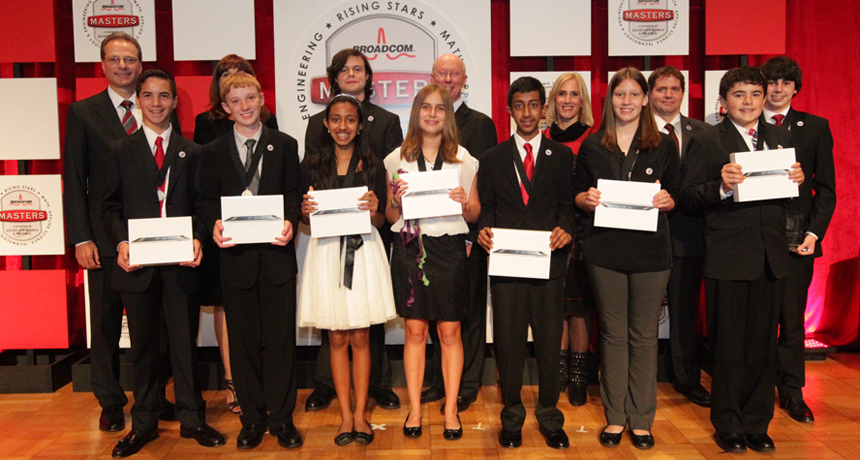
Seven of the eight finalists in the Broadcom MASTERS competition pose after receiving awards for their individual projects in the science, technology, engineering and math (STEM) fields. They are (left to right, starting with the front row): Keoni Gandall, 14, of Huntington Beach, Calif.; Johann Kailey-Steiner, 13, of Denver, Colo.; Sidhika Balachandar, 14, of Gainesville, Fla.; Rebecca Bloomfield, 14, of Colorado Springs, Colo.; Mihir Garimella, 14, of Pittsburgh, Pa.; Julienne Sauer, 14, of San Ramon, Calif.; and Austin McCoy, 13, of Rochester, Minn. Not pictured: Joshua Wentzel, 14, of Portland, Ore.
James Eaton (IML Photography)/SSP
By Sid Perkins
Even in the midst of a government shutdown, Washington, D.C., can be a busy place. At least it was for the 30 middle-school students who recently traveled to the nation’s capital to vie for prizes in a competition called the Broadcom MASTERS.
Each of the 14 girls and 16 boys qualified for the three-day research competition on the basis of a project entered at a local or regional science fair. The finalists, drawn from 17 states, conducted original research on everything from genetically engineered microbes to rocket flight.
The individual project counted toward just one-quarter of each finalist’s score. The remaining three-quarters depended on how well each student performed over a series of projects tackled as part of five-member teams.
“This competition’s really about how they can work as part of a team,” explains Paula Golden. She’s executive director of the Broadcom Foundation, based in Irvine, Calif. The Broadcom Foundation sponsors the annual Math, Applied Science, Technology and Engineering for Rising Stars — or MASTERS — competition. The event is a program of Society for Science & the Public, which also publishes Science News for Students.
At an awards ceremony on Oct. 1, two students took home the top cash awards of $25,000 and $10,000, respectively. They were not the only winners, however. Eight other students garnered major accolades as well. Here, we describe their individual projects.
“I like to think of the individual project as what got a student’s foot in the door here,” Golden says.
For these students, the competition provided first- and second-place awards in science, technology, engineering and mathematics. The four fields collectively are known by the acronym STEM. The prizes, worth $3,500 and $2,500, respectively, help defray the costs of attending a STEM-oriented camp of each winner’s choice.
The STEM winners, like their projects, are a diverse bunch. Let’s learn more about them — and the cutting-edge research that brought them to Washington.
Science
The two winners in this category can rightly be called part of the “California crowd.” Both hail from the Golden State (as did another three finalists).
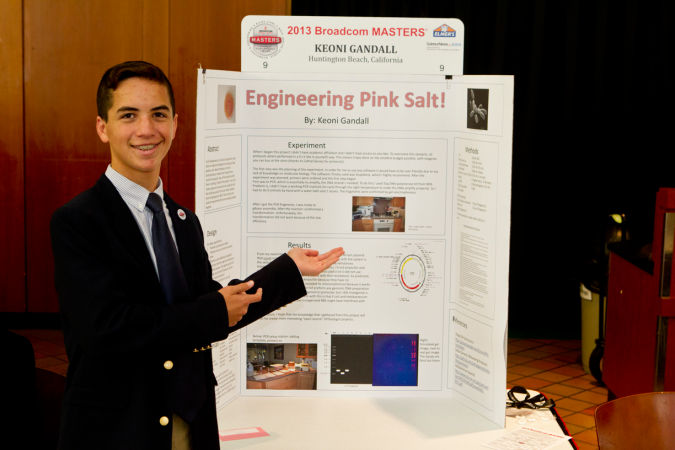
The project proved especially challenging because the species he chose grows very slowly. It also doesn’t take up bits of another organism’s DNA very readily, explains Keoni. And the technique he used to modify the microbe’s genes didn’t work as well as it had in previous projects.
In the end, Keoni also ran out of the expensive materials needed for the final step of this latest project. Even though Keoni didn’t complete that step, he did demonstrate how altering the organism’s genetic makeup was possible.
Best of all, Keoni says, the project taught him valuable lessons: For his next project, he will work with yeast. These organisms grow quickly and readily incorporate DNA. Such traits will make his future attempts at genetic engineering far more likely to succeed. One such project would involve adding genes that allow yeast to harness sunlight and make their own energy-carrying molecules.
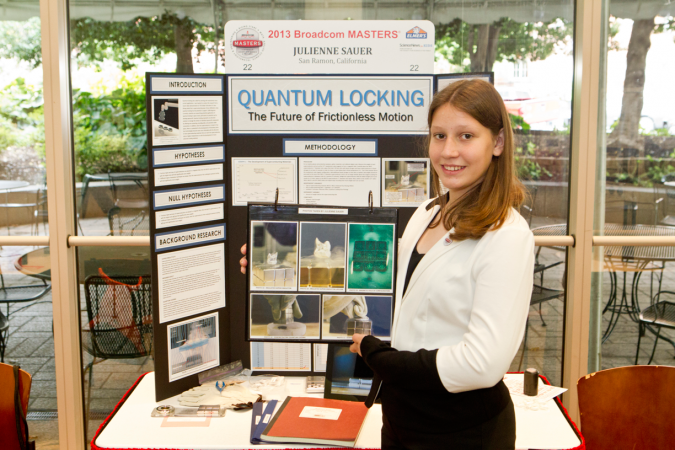
Julienne Sauer, 14, of San Ramon, claimed second place in the science category. She studied a high-tech material called a superconductor. Electricity flows through superconductors without resistance. (Most superconducting materials behave this way only when very cold.)
Inside a strong magnetic field, most superconductors will float in the air. Because superconductors move freely back and forth with little friction, they might one day help cut the energy used in many forms of transportation, including trains.
Julienne studied a less common type of superconductor. It too floats in the air when exposed to a strong magnetic field. But it doesn’t move freely back and forth. Instead, it rises into the air and remains in place, she explains.
Such materials could be very useful in the microgravity of space, Julienne notes. There, the materials could be incorporated into a mechanical arm, and used to move or manipulate space satellites undergoing repair. The superconductor would ensure the arm and satellite never made direct contact. That would minimize the odds of denting or otherwise damaging a satellite. It also would reduce the chance of electrical discharges, which can damage electronic equipment inside.
Technology
Winners in the technology category took home prizes for projects related to medicine and the environment.
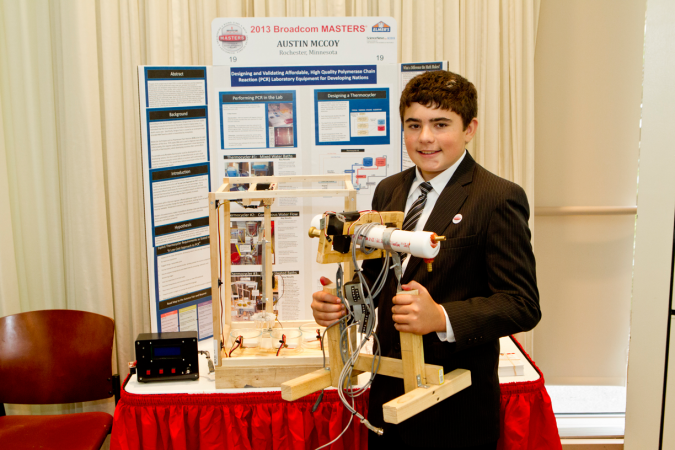
Large, bulky lab equipment already exists to do the same thing. But it typically costs about $10,000 or more, says Austin. His device is made from about $80 worth of parts, including pumps, valves, thermometers, some scrap insulation and a bucket. Austin’s version is also simple to use. And it provides answers in about 90 minutes. That is slightly quicker than the bigger lab devices now used.
Austin designed his device so that it can be taken apart and reassembled easily. Users can plug in the device to power it. They also can run it off solar panels or batteries. That means doctors could carry the device from clinic to clinic. They might even use it in poor regions without clinics or electricity, he notes.
“Being able to possibly help people in developing nations is a dream come true,” says Austin.
He worked with a mentor who is a scientist at the Mayo Clinic, located in his hometown. Next year, the two will make a trip to India. There, they plan to put the new device to the test in helping doctors fight a disease called dengue (DEN gee) fever. This devastating viral infection causes fever, severe headaches and muscle and joint pain. It infects up to 100 million people in the tropics and nearby areas each year.
Mosquitoes spread four different versions of the dengue virus, Austin explains. Doctors can’t identify the best treatment for the disease until they know which version infects a patient. Genetic tests using Austin’s device should be able to quickly provide that information.
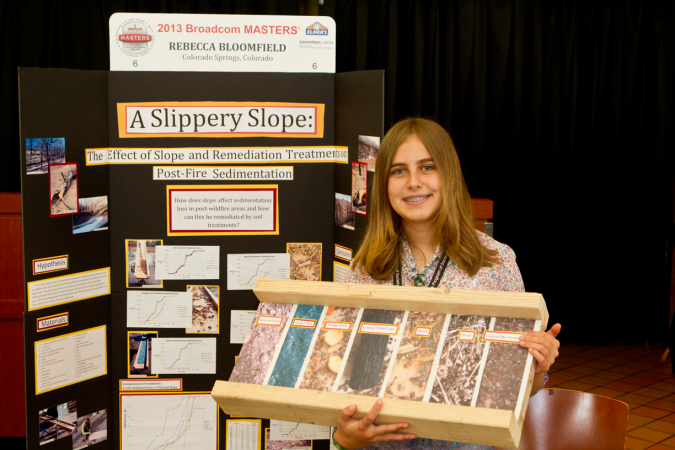
When Rebecca later visited these affected areas, she saw workers had spread straw over the ground. Their goal was to prevent freshly exposed soil from washing away — a process called erosion. But Rebecca knew since straw floats, it might wash away with the next big rain. She decided to investigate what other materials might prevent the steep canyons near her home from eroding before enough vegetation grew back to anchor the soil.
She started by building a broad wooden trough. Then she added pebbles and gravel to simulate the exposed soil on a newly burned hillside. The slant of the trough could be adjusted between 0 degrees (perfectly horizontal) and 70 degrees (similar to some of the steepest slopes nearby).
For each test, Rebecca covered the gravel with a different material to examine how well it limited erosion during a simulated rainfall. She used shredded wood, straw and orange peel mulch. She also tested small sections of logs staked in place. Adjusting the slant of the trough let her test the performance of the materials on different slopes too.
Rebecca simulated rain by spraying water over the trough, dousing it with as much as 12 liters (a little more than 2.6 gallons) each minute. That’s about as much water as would run across the surface during storms so extreme that they only strike her area about once every 25 years.
Rebecca had expected that the shredded wood mulch would prove most effective at stopping erosion. Her tests didn’t show that. Where the water flow over the ground was highest — especially where the slope was very steep — only the logs prevented the gravel from washing away.
Rebecca wants to one day become a field biologist. She hopes to use her cash award to travel to Washington State and attend “herp camp.” It’s where students work with herpetologists, those scientists who study amphibians and reptiles such as salamanders, frogs, snakes and turtles.
Engineering
Both projects that earned top awards in technology delight the senses — quite literally.
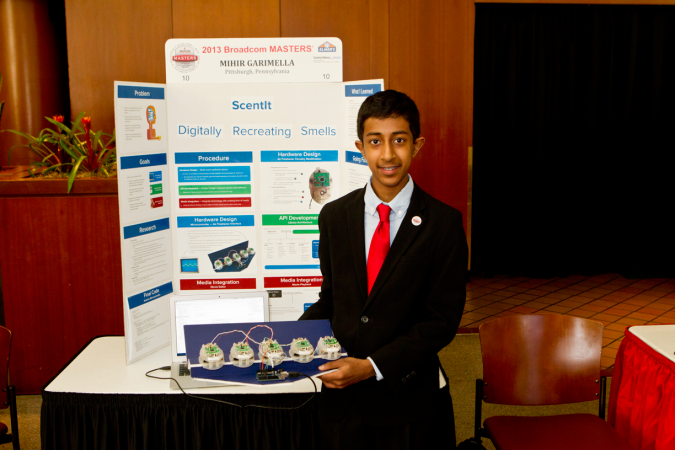
For his prototype, Mihir used five sets of parts from commercial air fresheners. He linked them to a computer so that it would release a controlled amount of one or more scented chemicals on command. (Research suggests that there are only 10 different categories of smells, says Mihir. That means it may take a device only a little larger than his prototype to recreate almost any scent, he explains.)
The teen would like to become a robotics engineer. So he may use his prize money to attend a summer camp, possibly at the Massachusetts Institute of Technology in Cambridge, or at Stanford University in Palo Alto, Calif. The opportunity would let Mihir learn even more about computer programming. So far, he already has developed a smartphone app used by more than 900 of his schoolmates.
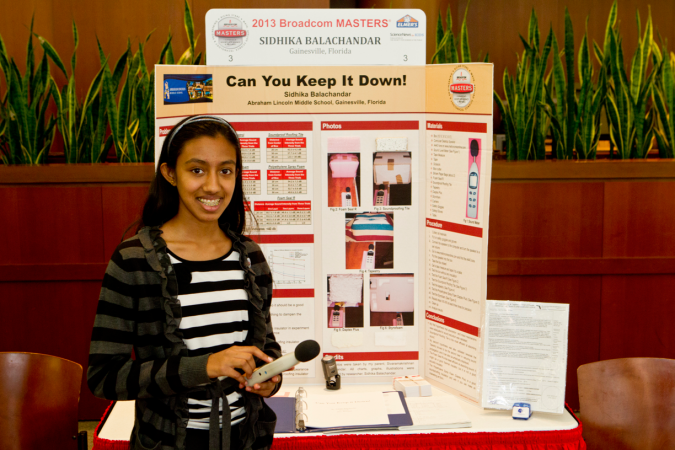
Sidhika started by placing a stereo speaker inside a cardboard box. She used the speaker to blare a consistent tone. She next used a sound meter to measure how loud the tone was at various distances from the box and at different angles. Those formed her baseline measurements. Then, she wrapped the box, using different insulating materials, and ran the sound tests again.
Sidhika blanketed the box with foam insulation (the type found in spray cans at many home improvement stores) and blocks of rigid Styrofoam. She also tested soundproofing tiles, just like those used in the false ceilings in basements and office buildings. She even tried wrapping the walls of the box in attractive tapestry fabric.
Some results produced “weird side effects,” she notes. “Sometimes, when I was farther away from the speaker — where the volume should have decreased — it actually increased.” She suspects the sound meter might have picked up echoes bouncing off of the walls of the room in which she ran her tests.
Ceiling tiles soundproofed best, Sidhika found. But two layers of tapestry performed almost as well. “Plus, that looks much better,” she points out, “and I think my mom would like it more.”
The teen would like to use her award to attend camp where she could study physics or engineering. “I want to be an engineer because I am good in science and math,” she says. “I am always curious about how things work or why something happens.”
Mathematics
Both of this year’s high-flying projects in the math category relate, in some sense, to aerodynamics. That’s the study of how air interacts with a solid object, such as a rocket or a cannonball.
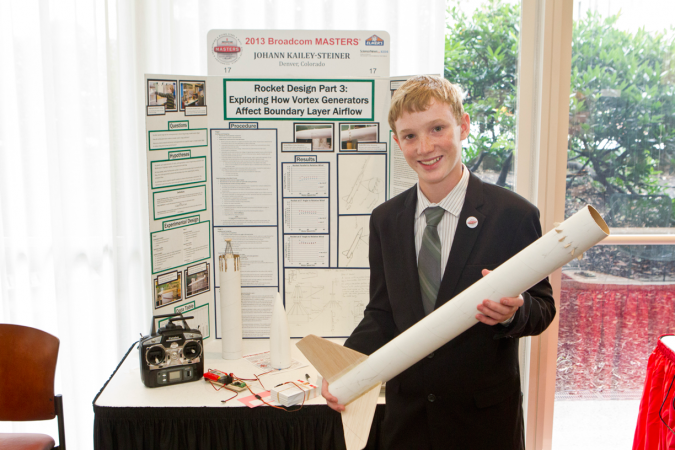
Johann Kailey-Steiner, 13, of Denver, Colo., claimed the top award in this category for reducing the drag on model rockets. Rockets experience drag as the slowing force exerted by air. He’s studied the same topic for three years straight. When he was 11, he tested a basic design for a model rocket. The following year, he noticed that a rocket would sometimes fly higher after small pieces of tape started to come loose from the rocket’s body. A closer look suggested those flaps of tape were causing turbulence in the air. And that seemed to cut drag, allowing the rockets to ascend higher.
This year, Johann wanted to take advantage of this drag-cutting phenomenon. So he added tiny blades to the outside of the rocket. The big challenge, he says, was figuring out where to place them.
When Johann tested his designs in a wind tunnel, he found the tiny blades cut drag only when he placed his rocket at a slight angle to the wind. In flight, this can occur after a rocket’s engine stops burning fuel. So, he designed the blades to pop out only once the rocket begins to slow, after its motor shuts off.
And it worked. Next year, he may try to determine the best size and shape for these tiny, drag-reducing blades.
Johann enjoys inventing and building models. He also like flying, and already has taken a few flying lessons. It is an interest that runs in his family: Both of his parents are pilots.
This summer, Johann would like to use his award to attend space camp. There he might get to experience, among other things, a realistic space-shuttle simulator.
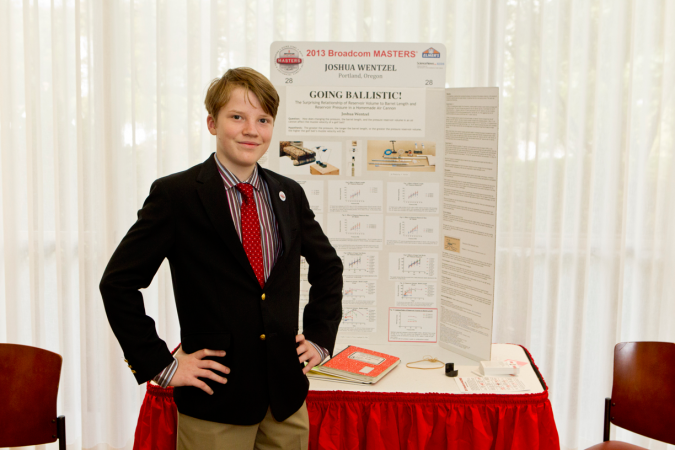
Joshua could change three aspects of the cannon: the length of its barrel, the volume of its air reservoir, and the pressure inside the reservoir. Oddly, tests showed that the highest pressure didn’t always make golf balls fly the farthest. Instead, the cannon flung them the greatest distance when the volume of the barrel and the volume of the pressure reservoir were nearly the same. Eventually, Joshua’s air cannon was firing off balls at speeds of more than 61 meters (200 feet) per second, or about 219 kilometers (136 miles) per hour.
Joshua hopes to become a mechanical engineer, but he’s also interested in computer programming. As soon as he returned home from the Broadcom MASTERS event, he stripped many of the cables from his family’s TV and used them to hook up the Raspberry Pi computer given to each finalist. (The next day, he went out and bought new cables of his own.)
Joshua plans to attend a science camp devoted to computer programming. He’s attended such camps before where he had great fun — and learned a lot — tweaking computer games to add players or other features.
All of these STEM champs illustrate the power of inspiration in conducting original research. And in many cases, a problem or passion quite close to home threw off that spark of inspiration.
Power Words
aerodynamic Having a shape that reduces resistance from air flowing past.
aerodynamics The scientific study of flowing air, especially when it interacts with solid objects such as an aircraft wing, a car or a tall building.
aerodynamic drag The force on an object caused by the friction of air flowing over its surface (see also drag).
app Short for application, or a computer program designed for a specific task.
archaeon (plural archaea) A domain of life that includes single-celled organisms. Although archaea superficially resemble bacteria, they are distinct. Archaea inhabit many harsh environments.
dengue fever A potentially lethal infectious disease transmitted by mosquitoes. No vaccine yet exists to prevent infection with the virus responsible for the disease, which causes high fevers, severe headache, joint pain, pain behind the eyes, rash, bone pain and sometimes mild bleeding. A more severe form of the disease, known as dengue hemorrhagic fever, can cause uncontrolled bleeding if not treated right away.
DNA (short for deoxyribonucleic acid) A long, spiral-shaped molecule inside most living cells that carries genetic instructions. In all living things, from plants and animals to microbes, these instructions tell cells which molecules to make.
drag A slowing force exerted by air or other fluid surrounding a moving object.
erosion The process that removes rock and soil from one spot on Earth’s surface and then deposits the material elsewhere. Erosion can be exceptionally fast or exceedingly slow. Causes of erosion include wind, water (including rainfall and floods), the scouring action of glaciers, and the repeated cycles of freezing and thawing that often occur in some areas of the world.
friction The resistance that one surface or object encounters when moving over or through another. Friction generally causes a heating, which can damage the surface of the materials rubbing against one another.
gene A segment of DNA that codes, or holds instructions, for producing a protein. Offspring inherit genes from their parents. Genes influence how an organism looks and behaves.
genetic engineering The direct manipulation of an organism’s genome. In this process, genes can be removed, disabled so that they no longer function, or added after being taken from other organisms. Genetic engineering can be used to create organisms that produce medicines, or crops that grow better under challenging conditions such as dry weather, hot temperatures or salty soils.
herpetologist A scientist who studies the biology of reptiles and amphibians.
magnetic field A region around a magnetic material where the force of magnetism acts.
microorganism A living thing that is too small to see with the unaided eye, including bacteria, some fungi and many other organisms such as amoebas. Most consist of a single cell.
prototype A first or early model of some device that still needs to be perfected.
smartphone A cell (or mobile) phone that can perform a host of functions, including search for information on the Internet.
Styrofoam A trademarked name for a type of rigid foam made from lightweight polystyrene plastic. It is used for everything from home craft projects to decorative ornaments and building insulation.
superconductor Materials that have no resistance to the flow of electricity, typically only when they are cooled below a certain temperature. Superconductors also repel all magnetic fields, which allows them to float in the air when they are placed inside a strong magnetic field.
turbulence The chaotic, swirling flow of air. Airplanes that run into turbulence high above ground can give passengers a bumpy ride.
wind tunnel A facility used to study the effects of air moving past solid objects, which often are scale models of real-size items such as airplanes and rockets. The objects typically are covered with sensors that measure aerodynamic forces like lift and drag. Also, sometimes engineers inject tiny streams of smoke into the wind tunnel so that airflow past the object is made visible.







